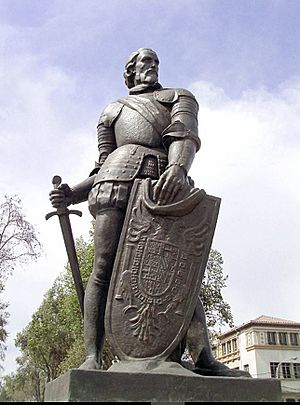Francisco de Aguirre (conquistador) facts for kids
Quick facts for kids
Francisco de Aguirre
|
|
|---|---|
 |
|
| Royal Governor of Tucumán | |
| In office 1553–1555 |
|
| Monarch | Charles V |
| Preceded by | none |
| Succeeded by | Jerónimo Luis de Cabrera |
| Personal details | |
| Born | c. 1507 Talavera de la Reina, Spain |
| Died | 1581 La Serena, Chile |
| Spouse | María de Torres |
Francisco de Aguirre (Spanish pronunciation: [fɾanˈθisko ðe aˈɣire]; 1507–1581) was a Spanish conquistador (a Spanish explorer and soldier) who helped conquer lands in Peru, Bolivia, Chile, and Argentina. He played an important role in establishing Spanish rule in these areas.
Contents
Early Life and Adventures
Francisco de Aguirre was born around 1507. His parents were Hernando de la Rúa and Constanza de Meneses. He joined the army of King Charles I of Spain. He fought in important battles like the Battle of Pavia and the attack on Rome in 1527.
In 1517, while in Rome, he was an Alférez (a military officer, like a junior commander). He was given the job of protecting a convent (a religious building). As a reward, the Pope allowed him to marry his cousin, María de Torres y Meneses. The King also made him Corregidor (a local government official) of his hometown, Talavera de la Reina.
In 1536, Francisco de Aguirre moved to Peru. He brought many people with him, including servants. He joined a group that helped rescue Gonzalo Pizarro, who was surrounded in Cochabamba. Between 1538 and 1539, he helped conquer the Charcas area. This region is now part of Bolivia. He served under the command of Diego de Rojas.
Exploring and Settling Chile
In 1540, Francisco de Aguirre heard that Pedro de Valdivia was going to conquer Chile. Aguirre moved his own soldiers to Tarapacá. He waited there for two months to join Valdivia's group. He had 15 horsemen and 10 foot soldiers.
Aguirre quickly became a trusted friend of Valdivia. He gained an important position in the new Spanish colony. He was named one of the Alcaldes (town leaders) of the first settlement, Santiago. On September 11, 1541, local Indigenous people led by Michimalonco attacked and destroyed Santiago. Aguirre was badly hurt while defending the city.
Rebuilding La Serena
On June 20, 1549, Aguirre was given a special job. He was made lieutenant governor of the area between the Atacama Desert and the Choapa River. His main task was to rebuild La Serena. This city had been destroyed by Indigenous groups from the north. Aguirre was chosen because he had shown he was strong in fighting and punishing Indigenous people.
On August 29, 1549, Aguirre officially re-established La Serena. He built a fort to protect it. Then, he led his troops to chase the Indigenous people. After this, the north of Chile became safer. However, it had fewer people and less labor available.
Founding Santiago del Estero
In 1552, Aguirre, who was Lieutenant General of La Serena, took control of Tucumán. This area was on the other side of the Andes mountains. He had a disagreement with Juan Núñez de Prado. Núñez de Prado did not recognize Valdivia's authority.
After exploring the area, Aguirre founded the city of Santiago del Estero del Nuevo Maestrazgo. This happened on July 25, 1553. Some historians believe the city was actually founded in 1550.
A Governor's Challenges
When Valdivia died in the Battle of Tucapel, his will was opened. It said that Aguirre should become governor if Jerónimo de Alderete was not available. Aguirre was in Tucumán when he heard the news. However, Francisco de Villagra had already become governor. This was because Alderete had died, and Aguirre was away.
Disagreement Over Leadership
Aguirre's friends in La Serena told him what was happening. He quickly returned there. The people of La Serena welcomed him as Captain General and Governor of Chile. He sent a message to the Cabildo (town council) in Santiago. He told them his troops were ready to support his claim to be governor, as Valdivia's will stated.
However, the Santiago Cabildo refused to accept this. They even disarmed the soldiers sent by Aguirre's brother, Hernando. To solve the problem, a request was sent to the Audiencia (a high court) in Lima. The court decided that the council had to follow Valdivia's will for six months. After that, the viceroy (a ruler representing the King) Andrés Hurtado de Mendoza, 3rd Marquis of Cañete would name a new governor. If the six months passed, Villagra would be the governor of the southern army.
Aguirre wanted to ignore this decision. But his forces were too small to fight Villagra's. So, he sadly accepted the verdict. In 1557, the viceroy's son, García Hurtado de Mendoza, arrived as the new governor. One of his first actions was to arrest both Aguirre and Villagra, even though they were polite to him.
Governor of Tucumán
The King and his advisors were not happy about Aguirre's imprisonment in Peru. In 1562, the Viceroy of Peru, Diego López de Zúñiga, appointed Aguirre as Governor of the province of Tucumán. This area was almost lost due to a large uprising by the local people. In 1564, Aguirre brought the region back under Spanish control.
During his time as governor, a rebellion was started by Jerónimo de Holguín. This led to Aguirre being captured. He was later freed.
The many problems during his time as governor led the viceroy to remove Aguirre from his position. Jerónimo Luis de Cabrera was named as the new governor. In 1576, Aguirre returned to Chile. He lived a quiet life in La Serena, where he was respected until his death in 1581.
Learn More
See also
Sources
| Government offices
|
||
|---|---|---|
| Preceded by none |
Royal Governor of Tucumán 1553–1555 |
Succeeded by Jerónimo Luis de Cabrera |

